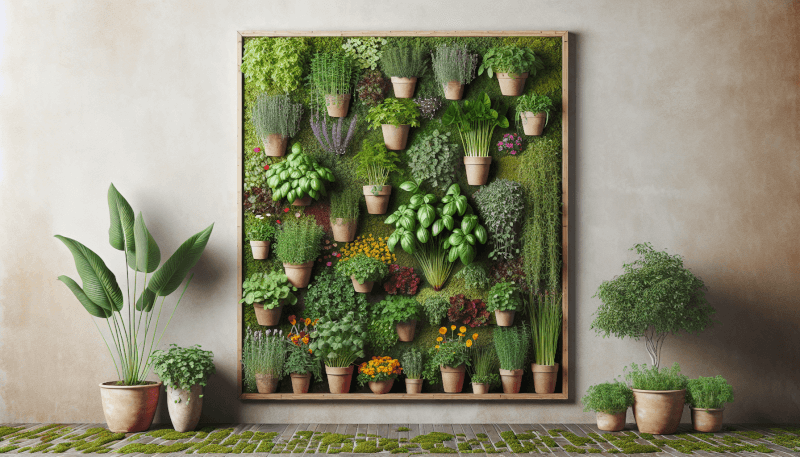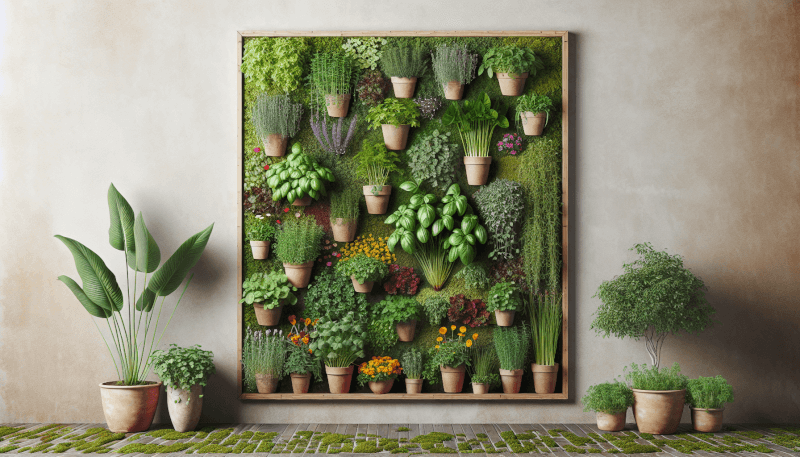You’re about to discover an ingenious way to bring a vibrant garden into your own space, no matter how limited it may be. In this article, we will explore the art of creating a vertical garden, a brilliant solution for growing healthy ingredients right at your fingertips. Whether you are a seasoned gardener or have never planted a seed before, this guide will provide you with simple and practical steps to transform any wall or corner into a lush oasis of freshness. Get ready to unleash your creativity and reap the benefits of home-grown goodness.

Choosing the Right Location for Your Vertical Garden
Consider the Amount of Sunlight
When choosing a location for your vertical garden, it is crucial to consider the amount of sunlight the area receives. Most plants require at least six hours of direct sunlight each day to thrive. Take note of any nearby buildings or trees that may cast shadows on your garden throughout the day. If your chosen location doesn’t receive enough sunlight, you may need to consider alternative options such as installing grow lights or choosing shade-tolerant plants.
Evaluate the Available Space
The available space you have will determine the size and scale of your vertical garden. Consider the dimensions and layout of the area you wish to utilize. Measure the wall or vertical structure where you plan to install the garden to ensure it is large enough to accommodate your desired number of plants. It is also important to leave enough space for maintenance, watering, and accessibility.
Assess the Climate Requirements
Different plants have specific climate requirements, so it is essential to assess the conditions in your location. Take into account the average temperatures, humidity levels, and any extreme weather conditions that may impact your vertical garden. Some plants thrive in tropical conditions, while others prefer cooler climates. By understanding the climate requirements, you can select plants that are well-suited to your specific environment.
Check the Soil Quality
Before setting up your vertical garden, it is vital to check the soil quality. Most vertical gardens utilize containers or raised beds, which means you have control over the soil composition. Ensure the soil is well-draining and fertile, as this will promote healthy plant growth. If the existing soil is poor quality, you may need to amend it with compost, peat moss, or other organic matter to provide the necessary nutrients for your plants.
Selecting the Ideal Plants for Your Vertical Garden
Pick Plants that Thrive in Vertical Environments
Not all plants are suitable for vertical gardening. It is essential to choose plants that have attributes allowing them to thrive in a vertical environment. Look for plants with compact growth habits, such as trailing vines or plants that naturally grow upright. Some popular choices for vertical gardens include herbs, succulents, lettuce, strawberries, and ornamental plants like ivy or ferns. Consider the size and spread of the plants when selecting them to ensure they fit within the allocated space.
Consider Growing Herbs and Vegetables
One of the many benefits of vertical gardening is the ability to grow your own herbs and vegetables. Herbs like basil, mint, or thyme can add a delightful aroma to your garden while providing fresh ingredients for cooking. Additionally, vegetables such as lettuce, tomatoes, peppers, and cucumbers can be successfully grown in vertical gardens. Not only will you have access to homegrown produce, but it can also save you money on grocery bills and reduce your carbon footprint.
Choose Plants with Similar Watering Needs
When planning your vertical garden, it is important to select plants that have similar watering needs. This ensures you can efficiently water your garden without over or under watering certain plants. Plants with the same watering requirements will also thrive together and provide a visually appealing display. Take into account the moisture levels different plants prefer and group them accordingly for easier maintenance.
Avoid Invasive or Spreading Plants
While some plants may seem attractive for vertical gardens, it is crucial to avoid invasive or spreading plants. These plants can quickly take over your garden and compete with other plants for resources. It can be challenging to control their spread, and they may negatively impact the health and growth of other plants. Research the growth habits and tendencies of the plants you choose to avoid any unwanted surprises in the future.

Building the Structure for Your Vertical Garden
Determine the Type of Support Structure
The first step in building your vertical garden is determining the type of support structure you will use. There are various options to consider, such as a trellis, wire mesh, grid panels, or a wall-mounted system. The choice of support structure will depend on the amount of weight it needs to bear, the available space, and personal preference. Ensure the structure is sturdy and securely attached to avoid any accidents or damage to your plants.
Decide on a Container or Trellis System
After selecting the support structure, you need to decide on the type of container or trellis system you will use. Containers can be as simple as pots or hanging baskets, or more complex with built-in irrigation systems. Trellises provide vertical support for climbing or trailing plants. Whichever option you choose, make sure it is suitable for the type and size of plants you plan to grow and that it allows for proper drainage and water retention.
Consider the Weight-Bearing Capacity
Before installing your vertical garden, it is crucial to consider the weight-bearing capacity of your chosen structure. Different materials have different load-bearing limits, and exceeding them can lead to structural damage or collapse. Take into account the weight of the containers, soil, plants, and additional water when calculating the overall load. Seek professional advice if you are unsure about the weight limitations of your chosen structure to ensure the safety and integrity of your vertical garden.
Ensure Proper Drainage
Proper drainage is essential for the health and longevity of your vertical garden. Without adequate drainage, excess water can accumulate, leading to root rot and other moisture-related issues. Ensure that your chosen containers or trellis system have drainage holes or include a reservoir to collect excess water. It is also essential to consider the positioning of your vertical garden to prevent water runoff from damaging nearby structures.
Preparing Your Vertical Garden for Planting
Clean and Disinfect the Containers or Trellises
Before planting, it is important to clean and disinfect your containers or trellises. This helps remove any dirt, debris, or potential pathogens that may harm your plants. Use a mild detergent or a solution of water and vinegar to clean the surfaces thoroughly. Rinse them well and allow them to dry completely before proceeding with the next steps.
Add a Suitable Growing Medium
The choice of a suitable growing medium is crucial for the success of your vertical garden. Depending on your preferred method, you may use potting soil, compost, coco coir, or a specialized growing medium designed specifically for vertical gardening. The growing medium should be lightweight, well-draining, and provide adequate nutrients for plant growth. Fill your containers or trellises with the growing medium, ensuring there is enough space for the plants’ roots to grow.
Create a Fertilizer or Nutrient Plan
To support healthy plant growth, it is essential to create a fertilizer or nutrient plan for your vertical garden. The specific needs of your plants will depend on their individual requirements. Consider using organic fertilizers or compost to provide the necessary nutrients for your plants. Be mindful of not over-fertilizing, as it can lead to nutrient imbalances or damage to the plants. Follow the instructions on the fertilizer packaging or consult with a gardening expert for guidance.
Water the Growing Medium
Once your vertical garden is prepared with the appropriate growing medium and nutrients, it is time to water it. Ensure the growing medium is evenly moist but not waterlogged. Different plants have varying water requirements, so it is important to monitor the moisture levels regularly and adjust your watering schedule accordingly. Avoid watering during the hottest part of the day to minimize evaporation.

Planting and Installing Your Vertical Garden
Transplant Seedlings or Arrange Cuttings
When planting your vertical garden, you have the option to transplant seedlings or arrange cuttings. Seedlings are young plants that have already germinated and have developed roots. They can be purchased from nurseries or started from seeds indoors. Cuttings, on the other hand, are portions of mature plants that can be rooted and grown into new plants. Whichever method you choose, ensure the plants have ample space to grow and spread their roots in the containers or trellises.
Position Plants According to Their Sunlight Needs
Proper positioning of your plants is crucial for their overall health and growth. Consider the specific sunlight needs of each plant and arrange them accordingly in your vertical garden. Plants that require full sun should be positioned where they will receive direct sunlight for the recommended amount of time each day. Shade-loving plants should be placed in areas that provide shade or filtered sunlight. By adhering to their sunlight requirements, you can maximize the productivity and aesthetics of your vertical garden.
Hang or Mount the Containers or Trellises
Once your plants are in position, it is time to hang or mount the containers or trellises onto the support structure. Follow the manufacturer’s instructions or seek professional advice to ensure proper installation. Make sure the containers or trellises are securely attached and evenly distributed to prevent any imbalance or strain on the support structure. Regularly check the tightness of the mounts or hangings and make adjustments as needed.
Secure the Plants to the Structure
To prevent your plants from being dislodged or damaged by wind or other external factors, it is important to secure them to the structure. Use plant ties, clips, or hooks to gently fasten the stems or branches to the trellises or support system. Be careful not to tie them too tightly, as this can restrict growth or cause damage. Regularly check the ties to ensure they are not becoming too tight or restricting the plants’ growth.
Caring for Your Vertical Garden
Monitor and Adjust Sunlight Exposure
Even after positioning your plants, it is important to monitor and adjust the sunlight exposure if necessary. Observe your vertical garden throughout the day and make note of any changes in the amount or intensity of sunlight it receives. If certain plants are receiving too much or too little sunlight, you may need to move them to a more suitable location. Monitoring also allows you to identify any shade patterns that may develop over time and make adjustments as needed.
Water Regularly and Avoid Overwatering
Regular watering is essential for the health and vigor of your vertical garden. The frequency of watering will depend on the specific needs of your plants, the growing medium, and the environmental conditions. Aim to keep the growing medium evenly moist, but avoid overwatering, as it can lead to root rot and pest infestations. Watering in the early morning or late evening, when temperatures are cooler, helps reduce water evaporation and ensures optimal absorption.
Apply Nutrients and Fertilizers as Needed
In addition to regular watering, your vertical garden may require additional nutrients and fertilizers to thrive. Observe the growth and health of your plants and make adjustments to your fertilizing routine as needed. Organic fertilizers or compost can be added periodically to enrich the soil and provide essential nutrients. Avoid over-fertilizing, as this can lead to nutrient imbalances and damage the plants. Follow the instructions on the fertilizer packaging or consult with a gardening expert for guidance.
Prune and Trim Plants to Maintain Shape
Regular pruning and trimming are necessary to maintain the shape and appearance of your vertical garden. As your plants grow, they may become unruly or develop uneven growth patterns. Pruning helps remove dead or diseased branches, promotes air circulation, and encourages new growth. Trim back any overly long or leggy stems to maintain a compact and attractive appearance. Be mindful of not removing more than one-third of the plant’s foliage at a time, as it may stress the plant.

Dealing with Common Vertical Garden Issues
Identify and Treat Pests or Diseases
Pests and diseases can pose a threat to the health of your vertical garden. Regularly inspect your plants for signs of pests such as aphids, mealybugs, or spider mites. If you notice any damage or suspect a pest infestation, take immediate action to identify and treat the issue. There are various organic pest control methods available, such as neem oil or insecticidal soap, that can effectively combat common pests. For diseases, ensure proper sanitation practices and promptly remove any infected plant material to prevent further spread.
Prevent Weed Growth and Competition
Weed growth can compete with your vertical garden plants for nutrients and resources. Regularly inspect your garden for weed growth and promptly remove any unwanted plants. Mulching the surface of the growing medium can help prevent weed growth and reduce water evaporation. Applying a layer of organic mulch, such as wood chips or straw, creates a barrier that impedes weed germination and helps conserve soil moisture.
Handle Environmental Challenges
Environmental challenges, such as extreme temperatures, strong winds, or heavy rain, can impact the health and growth of your vertical garden. Take proactive measures to protect your plants during adverse weather conditions. Providing shade cloth or windbreaks can shield your plants from excessive heat or wind damage. In the case of heavy rain, ensure proper drainage to prevent waterlogging and root rot. Adjust your watering and maintenance routines accordingly during these challenging periods.
Address Nutrient Deficiencies
If you notice any signs of nutrient deficiencies in your plants, such as stunted growth, discoloration, or poor flowering, take action to address the issue. Nutrient deficiencies can occur if the plants are not receiving adequate amounts of essential elements. Conduct a soil test to identify any deficiencies and adjust your fertilizing routine accordingly. Adding organic matter or specific nutrient supplements can help correct any imbalances and ensure the overall health of your vertical garden.
Harvesting and Using Your Vertical Garden’s Produce
Follow Proper Harvesting Techniques
As your plants grow and mature, you can start harvesting the fruits of your labor. Proper harvesting techniques ensure the best quality and flavor of your produce. Harvest herbs by gently snipping the stems just above a leaf node. For vegetables, carefully cut or twist the mature fruits or vegetables from the plant. Be mindful not to damage the remaining parts of the plant or neighboring plants during the harvesting process.
Enjoy Fresh Herbs and Vegetables in Your Meals
The beauty of having a vertical garden is the instant access to fresh herbs and vegetables right outside your doorstep. Incorporate the harvests into your daily meals to enjoy their vibrant flavors and nutritional benefits. Experiment with different recipes and combinations to fully appreciate the taste and variety of homegrown produce. Whether it’s adding freshly picked basil leaves to your pasta or harvesting lettuce for a salad, the possibilities are endless.
Store or Preserve Excess Produce
Inevitably, there may be periods of abundant harvests where you have more produce than you can immediately consume. In such cases, it is important to properly store or preserve your excess produce. Learn proper storage techniques for different herbs and vegetables to extend their shelf life. Consider drying herbs, freezing vegetables, or making preserves to enjoy your homegrown produce throughout the year. Sharing your excess harvests with friends, family, or local community centers can also be a rewarding way to spread the joy of vertical gardening.
Save Seeds for Future Planting
To ensure the sustainability and continuation of your vertical garden, consider saving seeds from your harvests for future planting. Harvest mature seeds from plants that have finished producing and store them in a cool, dry place. Label and date the seeds to keep track of their viability. When the time comes for the next planting season, you can use the saved seeds to grow new plants and continue the cycle of your vertical garden.

Expanding and Scaling Your Vertical Garden
Assess the Success of Your Current Garden
Once your vertical garden is thriving, take a moment to assess its success and evaluate any areas for improvement. Consider the overall health and growth of your plants, the productivity of your harvests, and the aesthetics of your garden. Reflect on what worked well and what challenges you encountered along the way. This assessment will guide your decision-making process as you consider expanding or scaling your vertical garden.
Consider Adding More Vertical Elements
If you have ample space and resources, consider adding more vertical elements to your garden. Whether it’s adding additional containers, trellises, or vertical panels, more vertical elements allow for increased planting opportunities and a visually dynamic garden. Be mindful of not overcrowding the plants and ensure each one has enough space to thrive. Plan the layout carefully to create an aesthetically pleasing and functional garden that suits your preferences and needs.
Replicate or Experiment with Different Plants
If you have found success with specific plants in your vertical garden, consider replicating them or experimenting with different varieties. Replicating successful planting schemes ensures consistent results and allows you to capitalize on the knowledge and techniques you have acquired. On the other hand, experimenting with new plants can expand your gardening horizons and introduce exciting flavors or aesthetics to your vertical garden. Enjoy the process of discovery and embrace the opportunity to learn and grow as a vertical gardener.
Explore Advanced Vertical Gardening Techniques
As you become more experienced with vertical gardening, you may want to explore advanced techniques and methods. These techniques can include hydroponics, aeroponics, or advanced irrigation systems that maximize plant growth and minimize water usage. Research and educate yourself on the various possibilities and technological advancements in vertical gardening. Always start small and gradually incorporate advanced techniques as you gain confidence and knowledge.
Conclusion
Creating a vertical garden can be a rewarding and fulfilling experience. By carefully choosing the right location, selecting suitable plants, building a sturdy structure, and providing the necessary care, you can enjoy a vibrant and productive garden right at your fingertips. Remember to regularly monitor and adjust sunlight exposure, water your garden appropriately, provide nutrients as needed, and address any issues that may arise. With patience, dedication, and a bit of creativity, you can create a thriving vertical garden that brings joy, beauty, and delicious ingredients to your life. Happy gardening!


